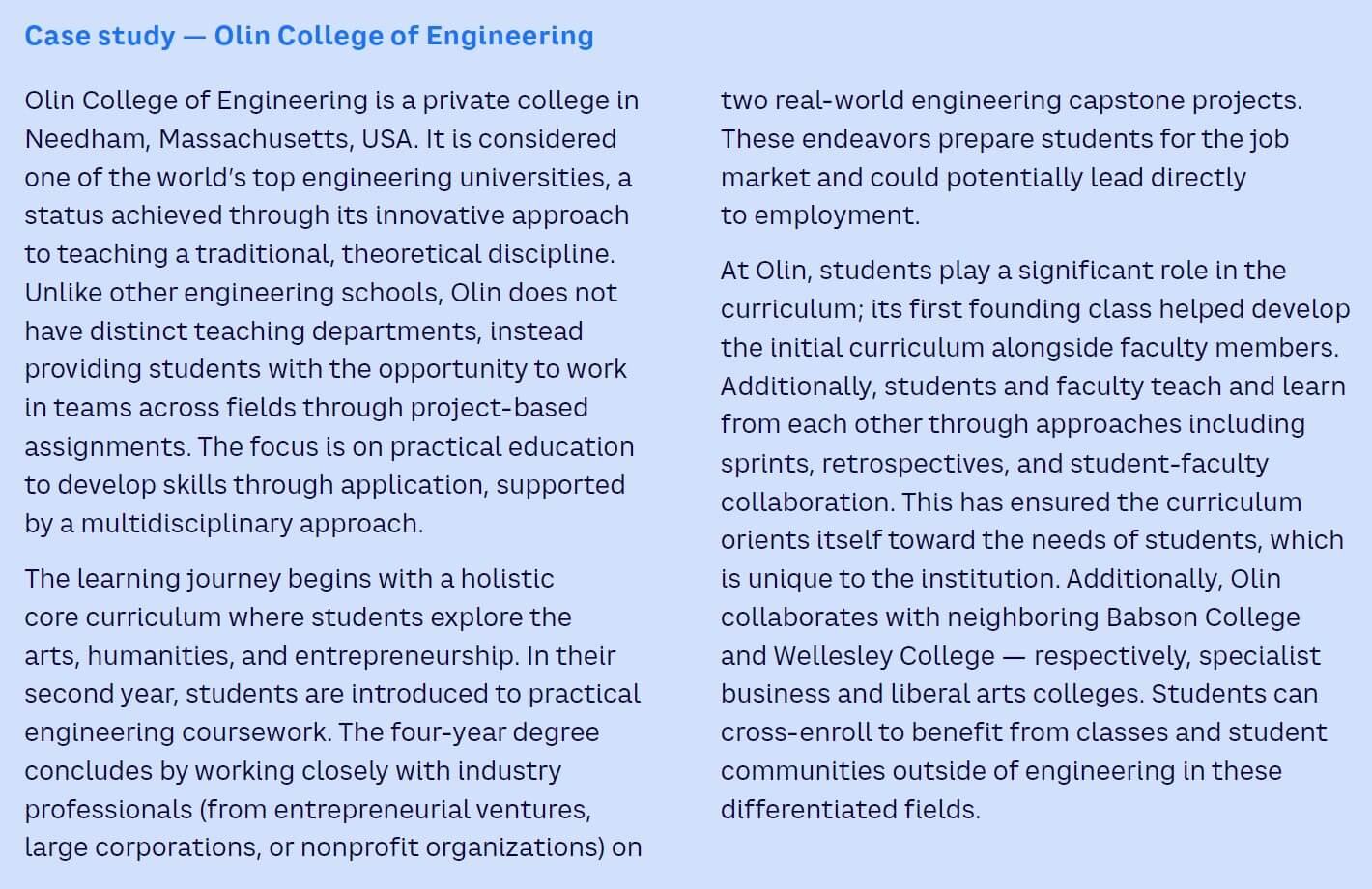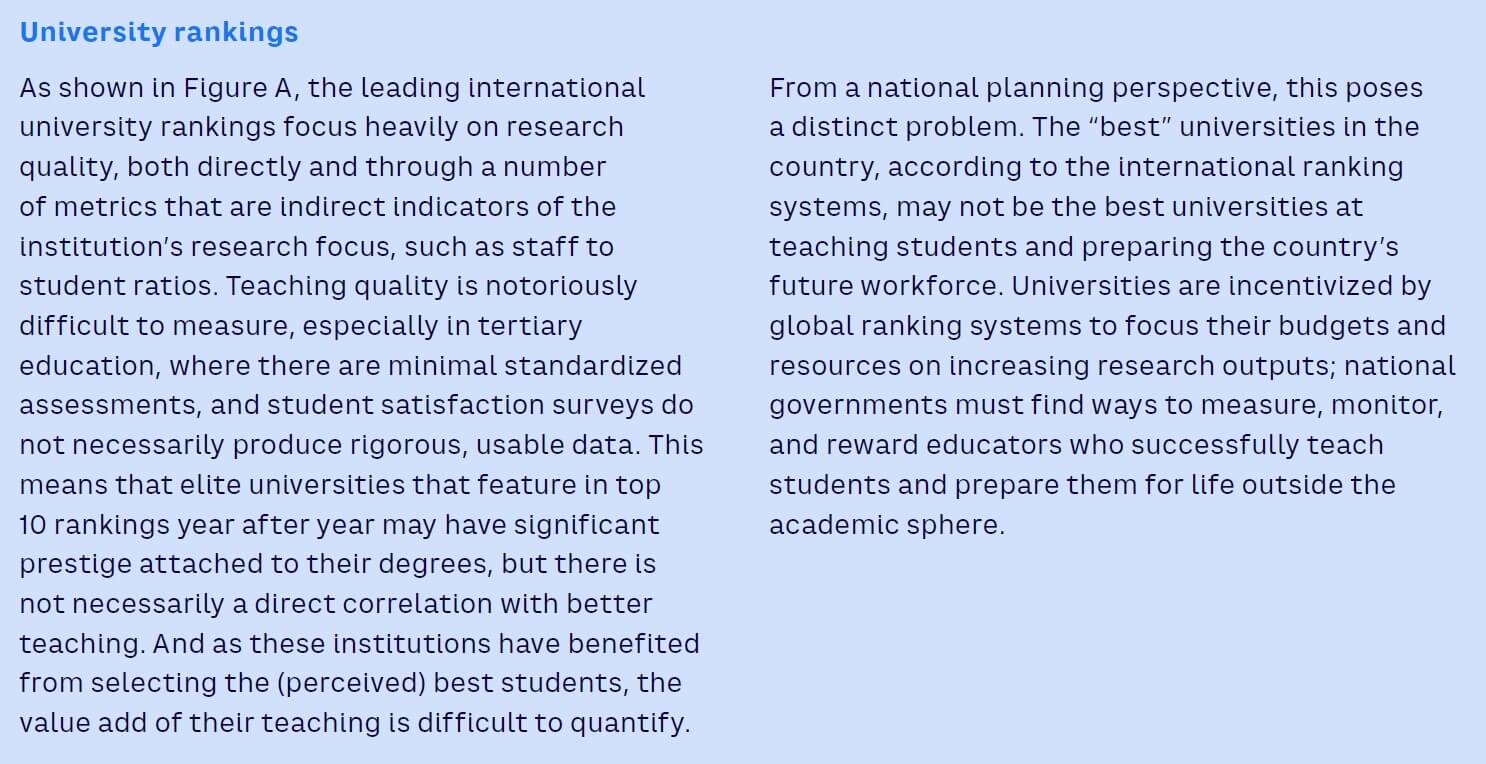26 min read • Technology & innovation management
The future of higher education, Part I
Balancing new requirements for research, teaching & student needs


Executive Summary
Since the turn of the millennium, modern universities have adapted and evolved from their public image as traditional old institutions of knowledge. However, they currently face a widening range of challenges brought on by our transforming, globalized world.
Universities must balance the conflicting demands between their traditional mission of teaching and research, while distinguishing themselves within a deepening pool of quality competition in an increasingly borderless market.
On the research side, funding is becoming more concentrated among a smaller group of institutions, but funding models are complex and can change rapidly. Universities are stepping up to share research and play their part in solving current global mega-challenges, driven by increasingly entrepreneurial academics and a focus on new ways of building innovation ecosystems to drive greater commercial relevance and revenues. On the teaching side, the pandemic’s impact on teaching hastened the rise and reach of digital learning — but it also underscored the value of experiential and personalized approaches to study.
Breakthroughs in artificial intelligence (AI), and the rise of commoditized online courses from nontraditional providers, increase pressure on universities. They must deliver quality differentiated teaching to a wider range of students who are looking to invest in lifelong learning and build skills over a longer (or shorter) period than the traditional four-year degree. Student needs are changing, and they increasingly demand a return on the time and money they invest in tuition.
The above conditions mean that individual institutions need to make strategic decisions around their future. Universities need to embrace changes in both how they are structured and how they operate and teach. They must reexamine their strengths in a global context and rethink traditional models around their missions of research and teaching to find their place in a changing world.
In this Report, we analyze the current context, describe the trends driving the higher education environment, and outline potential options for the future, based on a combination of Arthur D. Little (ADL) case work, sector knowledge, and interviews with thought leaders in education.
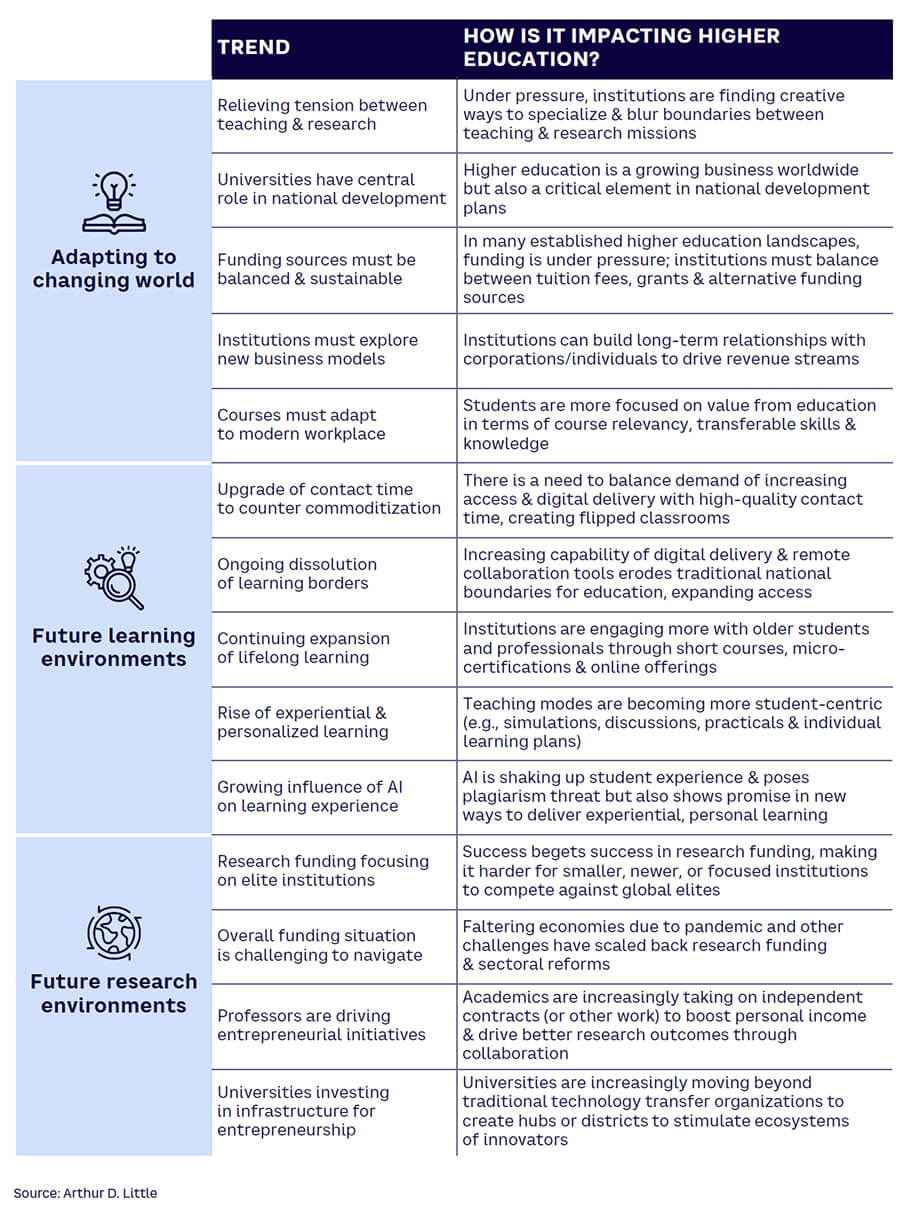
1
DEFINING THE FUTURE OF LEARNING ENVIRONMENTS
While the pandemic forced an overnight change in the delivery of university teaching, in many ways it simply turbocharged an existing shift toward digital learning, which caused many students and institutions to question how and where learning should take place. This rebalancing is still playing out, driving innovation in course delivery against a backdrop of a greater focus on improving the quality of in-person learning, lifelong learning, and nontraditional teaching options. What will the teaching mission of universities look like in the future?
QUALITY CONTACT TIME VS. COMMODITIZED LEARNING ENVIRONMENT
Since the pandemic required universities to go digital for lectures, seminars, and other learning experiences, there has been a reluctance to fully return to in-person instruction. This comes from both academic and student perspectives to differing degrees and links to changing student needs and a desire to maximize contact time.
While delivering university courses digitally enables institutions to scale up the number of students they can teach (thereby increasing revenue), virtual learning also brings challenges. It increases competition from universities at home and abroad and can lead to a degradation of teaching quality when there’s little to no upgrade in value of in-person time. Teaching institutions must ensure that even brief amounts of contact time with students maximizes the value of their learning. This may lead to “flipped” classrooms: lecture content delivered online but with greater efforts placed on highly interactive tutorials delivered to small groups.
As costs rise and students continue to question the economic value of a university education, there will be a much greater focus on teaching quality and the amount of in-person learning and its ability to affect future job prospects and build transferable skills.
BORDERLESS DELIVERY & DISTANCE LEARNING
The ongoing digital transformation of education provides significant opportunities for universities. It enables students from around the globe to effectively participate in learning activities, while removing constraints on scale in areas such as teaching facilities and student accommodations.
The last few years have shown that most lecture-based teaching can be delivered online. From that perspective, there’s little difference between a student’s bedroom in Cambridge or Santiago. The pandemic’s impact cannot be overstated. In the US, the number of undergraduate students exclusively enrolled in distance education courses was 186% higher in 2020 than 2019 due to the impact of COVID-19.[1] Importantly, those numbers have not changed much in the semesters since.
On the positive side, online learning has the potential to democratize access to some elite universities that have previously been unattainable due to high fees, travel costs, visa or residency restrictions, or living expenses in university towns such as Oxford. If universities wish to democratize learning, then borderless, digital delivery seems like an obvious enabler.
Distance learning is not new; the UK’s Open University began its primarily distance-learning programs in 1969. However, the continued growth of Web collaboration tools — video calls, virtual whiteboards, simultaneous-editing software, and potentially aspects of the Metaverse — further erodes the perceived barriers to educational delivery from afar. How institutions manage this shift and balance the physical and digital sides of their teaching mission will have fundamental impacts on their student numbers, revenues, and their ability to recruit potential researchers and academics in the future.
LIFELONG LEARNING
Today, people studying for a first degree are expected to change careers three to five times during their working life. One impact of this is a renewed drive for lifelong learning and upskilling in the professional workplace: applications to both online and in-person MBAs were up over 20% in 2021.[2] Global workplaces recognize that training and continuing professional development are key to attracting and retaining talent. Employers generally see this as a win-win; their employees gain skills, perform better, and have more reasons to remain with their employer. As technological inventions continue to change the modern workplace (witness the ongoing AI revolution), all employees will need to regularly learn new skills.
To meet their learning and development goals, many businesses have established partnerships with online educational content providers such as LinkedIn Learning, Kubicle, and Udemy. These courses range from basic topics, such as how to get the most out of spreadsheet software to more complex courses that delve into project management, sales, and business leadership. However, while the vast range of available options rewards the curious, these courses provide a relatively passive learning process that culminates in a quick test at the end of a video module. The student may engage with the course, but the actual learning reward is low.
In parallel, universities have gradually expanded the availability of massive open online courses (MOOCs), with educators from elite institutions adding more and more courses to platforms like edX and Coursera. In many cases, these courses are provided gratis or funded by modest accreditation fees from successful students. However, even within the academic field, the focus of course content has traditionally been around specific, job-related skills like business management and digital technology specialties such as data science. Relatively few rigorous options exist for ongoing and lifelong learning in core academic subjects — pure sciences, history, philosophy, literature — whether the goal is to build degree-equivalent knowledge or explore a new interest with the goal of becoming a more well-rounded individual.
Despite the boom in distance-learning, few options are available for professional or lifelong learning that fit around work schedules in the same way as an executive MBA, which combines intense, residential courses interspersed with distance learning over a multiyear period. This blueprint shows a way forward for universities and could even be enhanced through collaboration across institutions, allowing more open access to learning environments and providing micro-credentialed courses that over time may result in a degree. In this paradigm, a completed degree is not always necessary for lifelong learners, whose needs and interests may change depending on their current job, projects, and capability gaps. It is therefore important to allow for short or extended breaks, with flexible commitment and options to transfer credits gained into a foundation degree or other diploma.
All this means that universities need to innovate by offering options for shorter courses to capture interest and tuition dollars from the growing number of lifelong learners. Failure to do so will potentially undermine access to a lucrative, long-term teaching opportunity, which other international institutions or online-first players like LinkedIn Learning could capture. The sidebar “University MOOCs” lists some nonacademic content partners and the courses that generated the most interest.
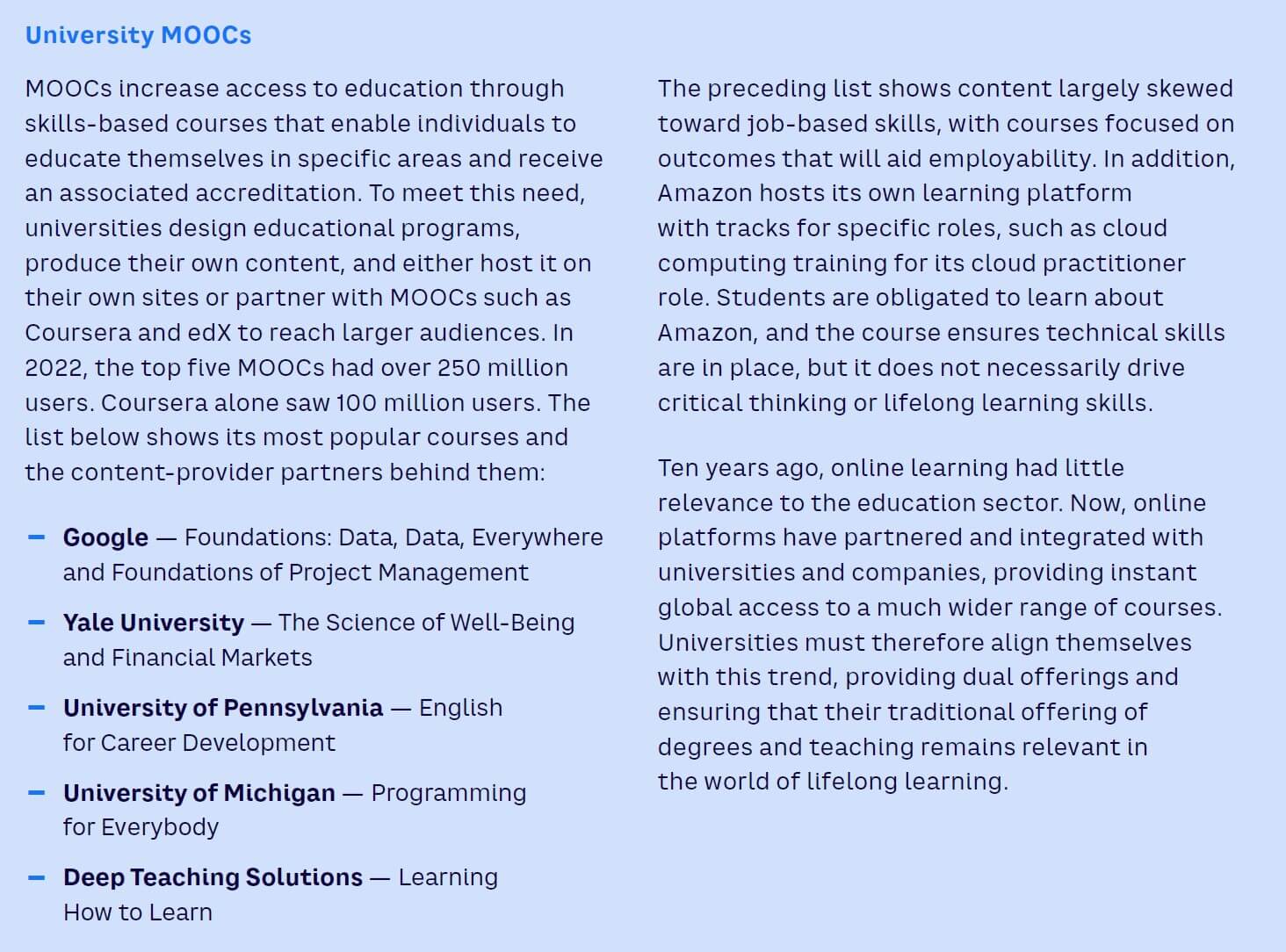
EXPERIENTIAL LEARNING
Experiential learning, which puts theory into practice, continues to grow. Rather than sitting in a lecture room or checking in online to passively absorb information, students are actively involved in learning and given the chance to explore and reflect on topics in a variety of situations: group discussions and projects, simulations and practicals, field exercises, and independent research, among others. Experiential learning has been shown to improve student satisfaction and understanding of key course materials,[3] as well as increasing the quality of in-person classes and improving students’ perceived value for the money.
The experiential approach is already common in certain settings, such as business schools, where case discussions, simulations, and project work (often examining real problems from real businesses) are the norm.
Experimental practicals have been part of science subjects and medicine since antiquity. Law students hold moot courts and mock trials to learn the art of argument and understand the reality of interpreting statutes. These opportunities help students apply their knowledge far beyond their theoretical understanding of course materials.
There are a multitude of ways to increase the use of experiential learning in the classroom, with different, potentially competing, pedagogies, such as problem-based learning, action learning, and simulation learning. Each approach focuses on a set of tools the educator can use to empower their students and help them learn more effectively.
There is a clear and growing trend to extend experiential learning to other settings. For instance, history students at Queen’s University in Kingston, Ontario, Canada, are offered the opportunity to gain degree credits through internships as archival and research assistants within the university or with a variety of partner museums. Similar programs at other universities may focus on capturing oral histories or curation. Universities, and more importantly, employers, are encouraging students to engage in internship programs, with employers expecting to offer 9.1% more internships in 2023 following an already-substantial increase of 22.6% in 2022 (see Figure 1).[4] These programs act as differentiators for courses, drawing in a wider set of students and also, in theory at least, hitting that key modern KPI for universities: graduate employment rate.
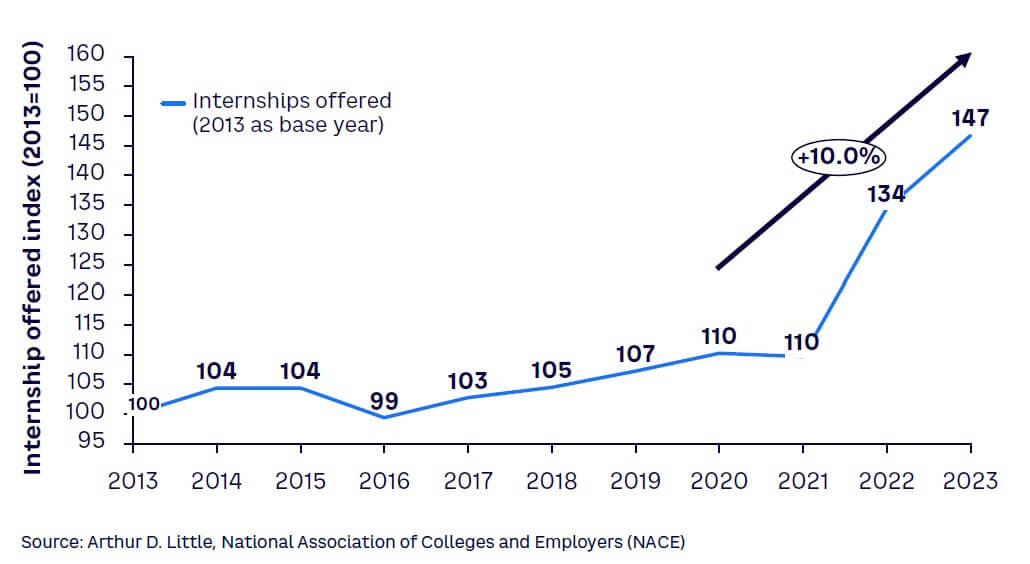
At least to some degree, the growing rise of experiential learning is in opposition to the trend of increased digitalization. In its most common form, structured classroom discussions, experiential learning puts face-to-face student interactions at the forefront of teaching. This type of interaction was most challenged by the pandemic-enforced switch to digital-first teaching and shows the need for balance between the physical and the virtual worlds.
While future Metaverse environments may solve issues of fidelity, providing remote interactions with the same levels of quality and immersivity as in-person groups, this currently seems a long way off.
However, to increase its adoption, experiential learning may need to overcome challenges in how people perceive it. For many, the key benefits of experiential learning are that it builds transferable skills that make students more employable, a concept that is challenging for many academics. These educators need to understand that experiential learning is also a powerful method for reinforcing, exploring, and testing subject-specific knowledge, and it well prepares students to become effective researchers, should they choose that pathway (see sidebar “Case study — Olin College of Engineering”).
Students who take a paid internship are more than twice as likely to land full-time job offers after graduation (see Figure 2). Even those who accept unpaid internships still benefit from the experiential learning, with a 1.2x increase in job offers received.[5]

PERSONALIZED LEARNING
Students want a personalized learning experience. Currently, most students can select modules within degree programs or come to university undeclared and gradually specialize, but these are examples of modularity — not true personalization. Within each block of the learning journey, students are expected to do the same problem sets, attend the same lectures, and examine the same concepts.
By contrast, personalized learning recognizes that students bring their own context, ways of working, and personal goals to the classroom environment. The learning journey therefore needs to be customized, at least somewhat, to meet these needs.
Personalized learning thrives on direct, individual contact between teacher and student. Without this connection, it is difficult to truly adapt teaching materials to the needs of the student.
The Universities of Cambridge and Oxford in the UK offer examples of undergraduate teaching utilizing an approach that relies on small discussion groups commonly comprised of two students and one supervisor. This configuration allows for a high degree of personalization and a focus on topics and challenges individual to each student. Though this approach to teaching is consistently perceived as powerful, it places a large time burden on academics and is expensive to deliver. However, even this framework does not necessarily represent truly personalized teaching; students are expected to follow the same reading list and listen to the same lectures as the rest of their cohort and answer the same questions to explore themes at the same time.
In general, project work can provide more fruitful opportunities for personalization, whether in a group or independently, which ties in with experiential learning. Within a set assessment framework, not all projects will focus on the same topic, or be completed following the same process, as long as students are given opportunities to develop and show key skills that are relevant to the course. Project teams can be structured to allow each student to focus on a particular topic or skill that they wish to develop further.
Delivering personalization at scale is a key challenge recognized by educators. The role of technology in supporting personalization remains unclear, with many believing it simply increases choice, rather than encouraging students’ drive to learn and seek out knowledge on their own. If it can be delivered cost-effectively and at scale, personalized teaching, delivered in person or virtually, provides a key path for universities to meet changing student needs and differentiate themselves from their peers.
CORPORATE-LED RECRUITMENT & TRAINING PROGRAMS
Within certain industries, particularly the technology sector, students are increasingly looking toward nontraditional teaching options. For example, bootcamp-style courses — intensive, immersive, and experiential — promise to teach the fundamentals of a skill in an incredibly compressed time frame. Crucially, many of these systems do not take an up-front fee but instead request payment based on results (e.g., getting a job in a new sector or a significant pay and/or responsibility increase).
This is an ideal approach for many students. Courses are short; minimizing up-front investment in time and opportunity cost, widening the potential applicant pool to candidates with nontraditional backgrounds. The connection to industry is particularly appealing, as for many the aim is to retrain and upskill to earn higher wages and more stable career options.
Corporate training and certification programs are also gaining popularity. For instance, many technology companies provide online platforms that offer employees the chance to become certified in their technology, with learners working toward gaining levels or badges and increasing their employability options.
There is a positive side here: any student with Internet access has multiple options to learn vocational skills that are vital across different industries and working environments. Often, learning opportunities are tightly tied to an industry (or company) and administered through industry-sponsored courses at universities, online bootcamps, and other learning environments.
However, there is a risk that such courses teach students specific ways of working and thinking that most benefit the corporation of employment, not the student.
While many academics wouldn’t consider corporate-led education the democratization of learning, it does provide students with a greater range of options. However, it may result in students forgoing traditional university programs and courses, which would pose a challenge to some institutions.
AI’S IMPACT ON STUDENT EXPERIENCE & LEARNING
Educators clearly cannot ignore the AI-sized elephant in the room. Students have more capability at their fingertips than ever before, not just around access to information, but through access to generative AI technologies such as ChatGPT and the underlying technology of large language models (LLMs). This will continue to develop at a pace that will inevitably feel unpredictable and difficult for institutions to manage. As in many sectors, adapting to new AI tools in education will take time, and appropriate ethics guidance is needed to deal with challenges such as underlying data and idea ownership for LLMs, which make discussions on plagiarism and accusations of cheating even more charged.
This changing, AI-driven world requires institutions to build critical thinking skills in all students: traditional undergraduates and graduates, working students, and lifelong learners and teach them ethical ways of working that set sensible boundaries for utilizing AI in the classroom. As Will Douglas Heaven wrote in the MIT Technology Review earlier this year, cheating is not a new phenomenon in higher education, and “schools have survived calculators, Google, Wikipedia, essays-for-pay websites, and more.”[6] Outright bans on using such technology are counterproductive, as generative AI technologies will become folded into the workplace across creative and knowledge industries, and are likely to be quickly circumvented by technology developers and students. Working with AI tools will be an expected skillset of graduates, much like data analysis in spreadsheet software or research skills beyond googling.
The new reality of LLMs actually increases the need for universities to provide personalized and experiential learning, with the student at the center of the learning environment, developing skills and knowledge in ways that (currently, at least) can’t be outsourced to AI. An experiential learning environment leaves little room to hide for a student who is overly reliant on hands-off tools to research and make decisions. Some educators are even using ChatGPT in an experiential learning setting: using the AI-driven tools as a collaborator in roleplay scenarios and debates or using (flawed) outputs from the LLM to trigger class discussions on reliability and accuracy of sources.
As the power of LLM technologies improves, the applications may become more and more focused on personalization of materials and assignments. Academics who test the waters with these general techniques will now be able to better leverage the next generation of education-specific tools and ultimately drive better student-centric outcomes.
2
WHAT SETS ELITE UNIVERSITIES APART?
Popular culture often espouses the view of universities as ivory towers, with academics walking the dusty halls of venerable institutions, conducting brilliant research and making breakthroughs in relative isolation.
The reality is undoubtedly different: the modern academic is engaged and entrepreneurial, well-networked, and works with partners, all the while conducting research. While this has always been true to a degree, research is constantly adapting to the changing pressures of the modern world, and the ecosystems built around university research and researchers are becoming ever more complex as a consequence.
The source of tension in university research comes from the drive toward applying research (research impact, in the language of funding bodies) and genuine blue-sky thinking. With funding and institutional war chests even more stretched, openings for truly revolutionary investigations seem tighter than at any point since World War II. How institutions maintain their identity and raison d’etre or redefine themselves without simply becoming cost-effective innovation centers for industry, will determine the winners and losers for the next phase of university development.
Research plays a fundamental role in university life, and it is growing in importance as a revenue source and a means of bringing prestige to the institution. Educators and universities are becoming more entrepreneurial as they build wider innovation ecosystems around their research strengths.
RESEARCH FUNDING FOCUSES ON ELITE INSTITUTIONS
Across the globe, R&D excellence is a key criterion for accessing any form of research funding, especially public grants. In 2022, for example, 80% of the UK’s research councils’ funding went to just 10% of higher education institutions (of about 200 total institutions) as shown in Figure 3. To succeed and attract grant funding, universities must be able to prove the efficacy, relevancy, and impact of their research programs.
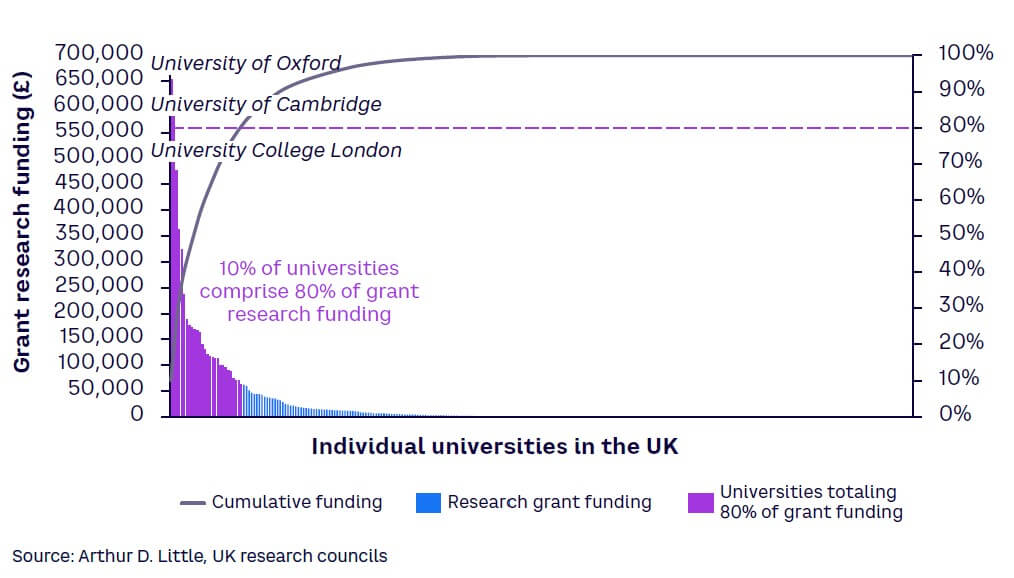
Universities often have to comply with a complex mix of KPIs when verifying their research success. These include research-related indicators such as successful patent applications and direct research-evaluation mechanisms.
High-quality research benefits a university in ways beyond the grant. It helps attract talented academic staff and facilitates international collaborations. In turn, these outcomes allow the university to compete for global students by trading on the prestige associated with its reputation (see Figure 4).
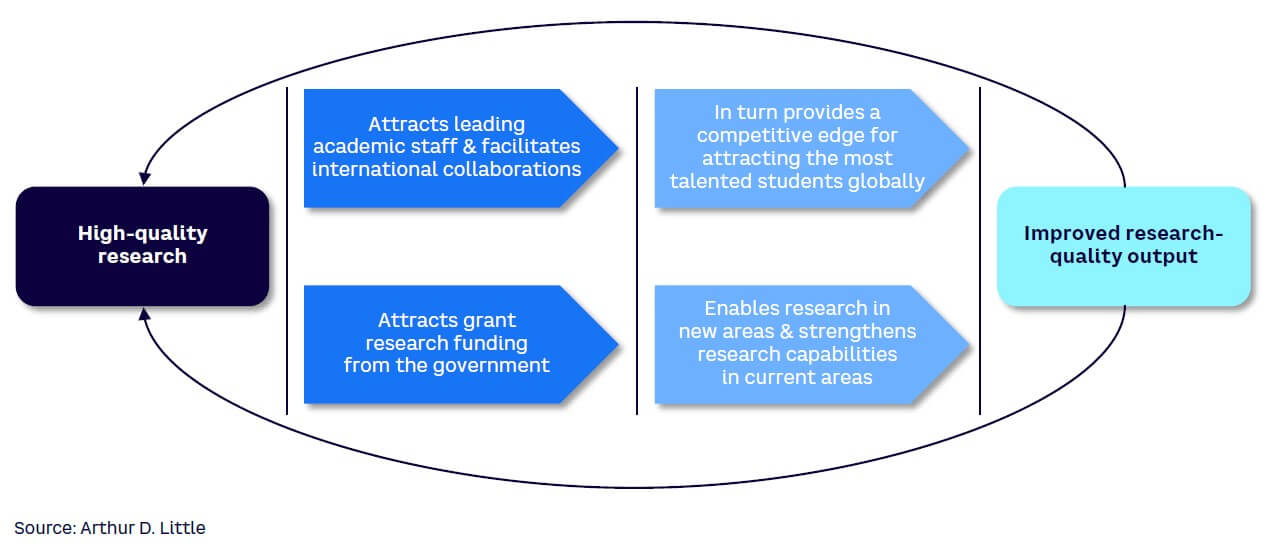
A CHALLENGING PICTURE FOR OVERALL FUNDING
Public funding for higher education continues to be challenging in many countries. In Europe, reforms to public funding were put on hold during the academic years 2019–2020 and 2020–2021 due to the impacts of the pandemic, and tuition costs are expected to remain largely static, despite inflationary factors. These conditions increase the pressure on universities to maximize their research income. On the positive side, many governments (e.g., Saudi Arabia, Singapore, and Malaysia) have increased funding in both relative and absolute terms, wanting to realize the potential their universities have to gain national prestige.
Funding challenges mean that research remains a critical driver for university revenue in terms of direct public funding, whether in the form of research grants or through funding formulas. However, basing a university business plan solely on public funding for research and teaching seems destined to lead to complications in the short and medium term, as KPIs can shift rapidly. If states move away from direct funding models or focus their funding on a handful of prestigious, highly effective, and focused research institutions, questions will arise on the funding model for the majority of non-research-intensive institutions in the landscape.
ENTREPRENEURIAL PROFESSORS DRIVE THEIR OWN DESTINY
Leading academics have long been multitaskers: overseeing research initiatives, raising funds, mentoring postgraduate students, and lecturing undergraduates. Senior academics shoulder the additional weight of facilitating public outreach and wooing alumni and businesses for donations; their role is clearly complex and multifaceted.
Despite their already significant workloads, there is an increasing trend for professors to secure their own incomes outside the university system: whether through collaborations with publishers to write textbooks (often taking a sabbatical) or via freelance engagements, such as working with governments, nongovernmental organizations, nonprofits, businesses, media groups, and consultancies as advisors with expertise in particular topics.
A professor’s professional network is key to entrepreneurship, as shown in Figure 5. Their ability to leverage global contacts (built through conference attendance, research collaborations, and industry partnerships) to form a sustainable pipeline of extracurricular activities is vital.
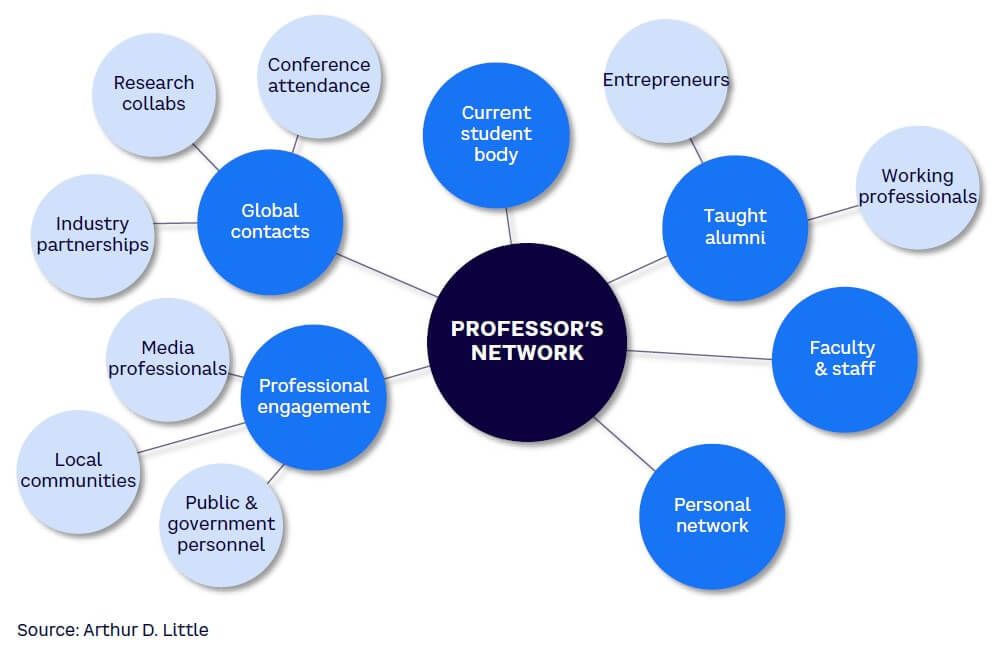
The student body also should be seen as part of the professor’s network; early career entrepreneurs frequently look to their professors for mentorship and advice, which may be converted into lucrative positions on boards or advisory committees.
While some advisory positions might be organized through the university, most external roles are accessed independently. In this regard, professors are not always well served by their understanding of contracts, business operations, or the value they add and would benefit from professional training from their institution or, if applicable, their union. Courses in entrepreneurship can provide the knowledge they need to consider entrepreneurship (see sidebar “Case study — Teaching researchers to be entrepreneurial”).
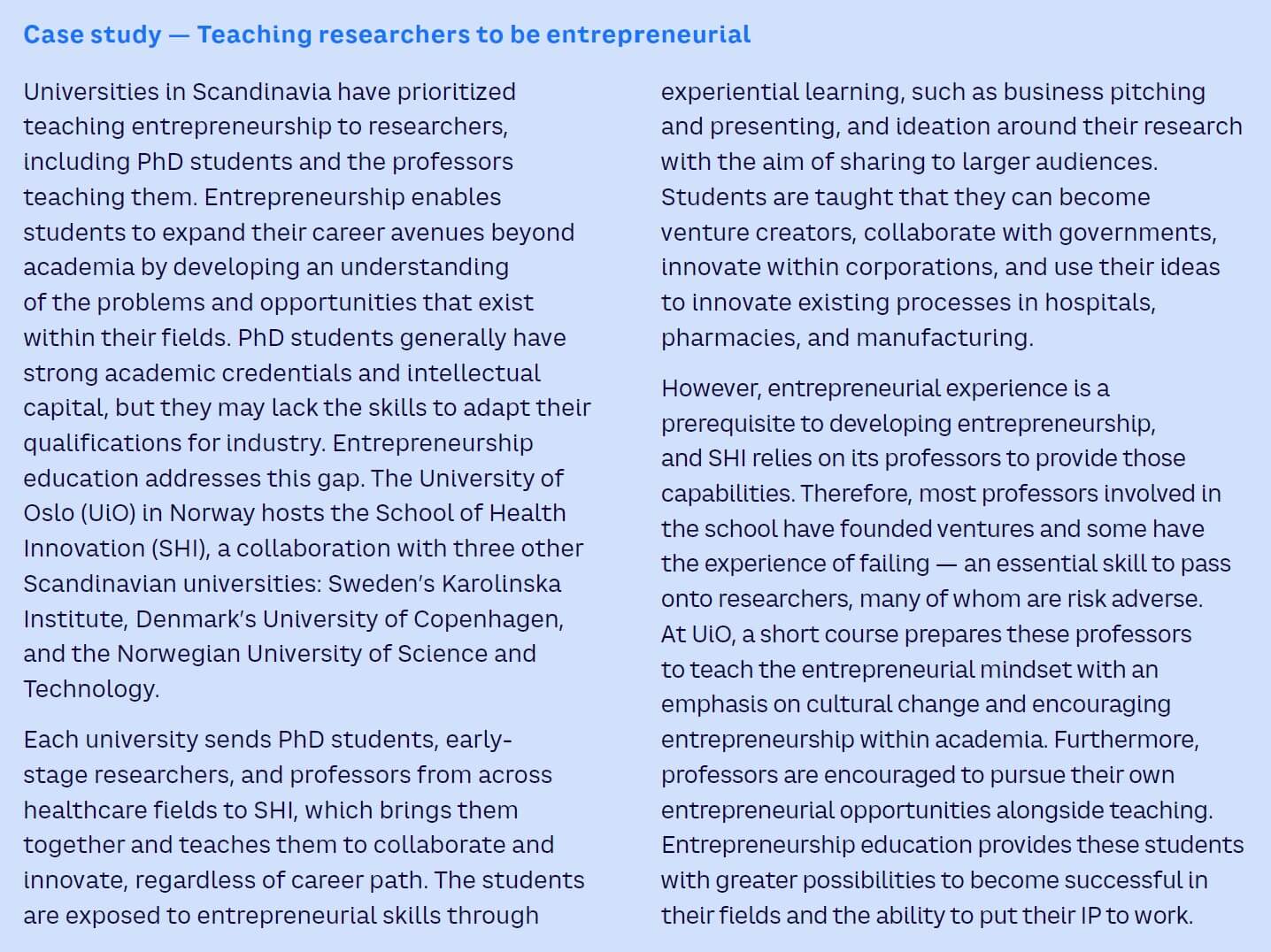
INFRASTRUCTURE INVESTMENTS SUPPORT UNIVERSITY INNOVATION
Because of the challenges around research funding, universities increasingly look to leverage existing assets and capabilities to create revenue streams that go beyond a pure intellectual property (IP) offer. The trend for creation of innovation districts, technology valleys, or advanced research parks is growing. This encourages spinouts, noninstitutional start-ups, and large flagship businesses with locations in the heart of the university campus, with ready access to students, recent graduates, and facilities.
Innovation districts (see sidebar “Innovation districts go beyond traditional TTO”) are not simply operating a technology transfer office (TTO), which focuses on maintaining and directly utilizing the institution’s IP. Instead, these entities aim to create a cooperative ecosystem of public and private research, in which (from the university’s perspective) spinouts are created regularly and have a higher chance of succeeding. This will ideally benefit the university’s revenue stream in the long term.
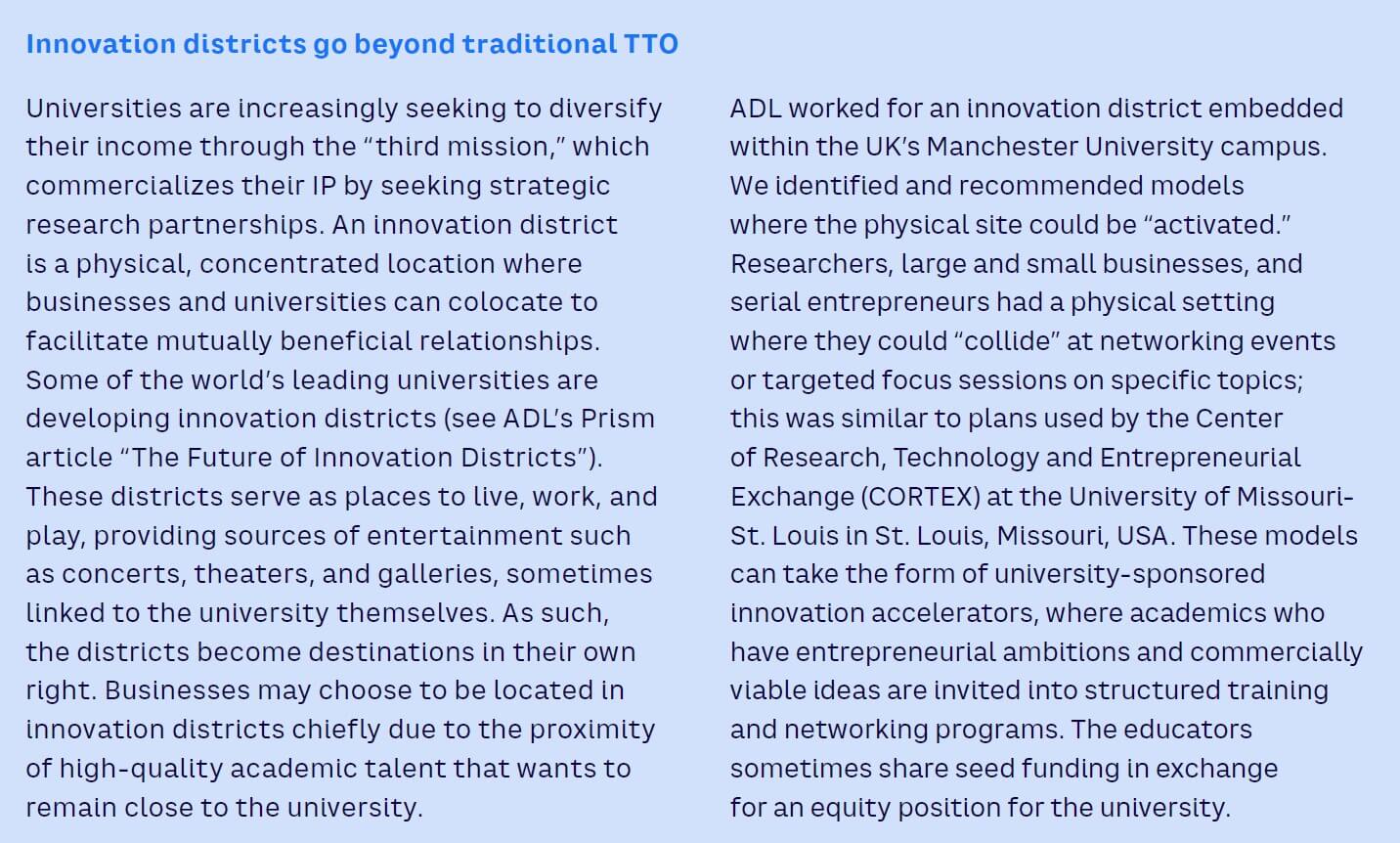
However, an innovative ecosystem also delivers wider benefits. It provides a diverse pool of engaged resources for the university to collaborate with, creating an open-door policy between the public and private sector. Ultimately, this should result in a more vibrant, more collaborative, and more varied university campuses, with research activities happening daily to benefit both the long-term prospects of students and the university’s daily teaching and learning.
Universities at the beginning of their innovation district journey should ensure these programs do not focus solely on STEM (science, technology, engineering, math) subjects and that students and faculty members from arts, humanities, social sciences, and business are welcomed and integrated into the ecosystem, not just as employees of innovative businesses (e.g., marketers, finance experts, lawyers), but fundamentally as cocreators and collaborators. Diverse skill sets and personal experiences will drive higher chances of success, and an innovation district should ultimately aim to become a collision space for interdisciplinary working.
It is critical for a university to consider how to create a careful balance between commercially focused research that could deliver venture capital or licensing returns and the type of fundamental research projects that are central to a university mission.
3
ADAPTING TO A CHANGING WORLD
The needs of students, governments, and the wider community are changing. This calls into question the overall mission of universities at an individual, institutional level. What value do they bring, and how do they justify their funding in a transforming world? How should they structure themselves to differentiate and add value? The answer requires them to understand and act on a number of challenges.
RELIEVING THE TENSION BETWEEN RESEARCH & TEACHING
Universities are under pressure from a globally mobile, demanding, and financially literate student base and a narrowing of research funding to a small group of institutions.
They therefore face a growing challenge to define their purpose and mission: is their university of the future a place for learning or a place for research? Traditionally, many have done both. After all, the two are intertwined; students benefit significantly from academics who are world-renowned experts in their field, and excellence in teaching creates a cohort of engaged researchers.
However, the skills required to be an academic expert and those of an engaging teacher are very different. The stereotype of the professor who is reluctant to leave the lab to teach or simply reads from their latest work still holds a grain of truth. In many parts of the world, students pay significant sums of money to universities, incurring lifelong debt in the process, so they increasingly seem within their rights to expect and demand high-quality teaching (see Figure 6).[7]
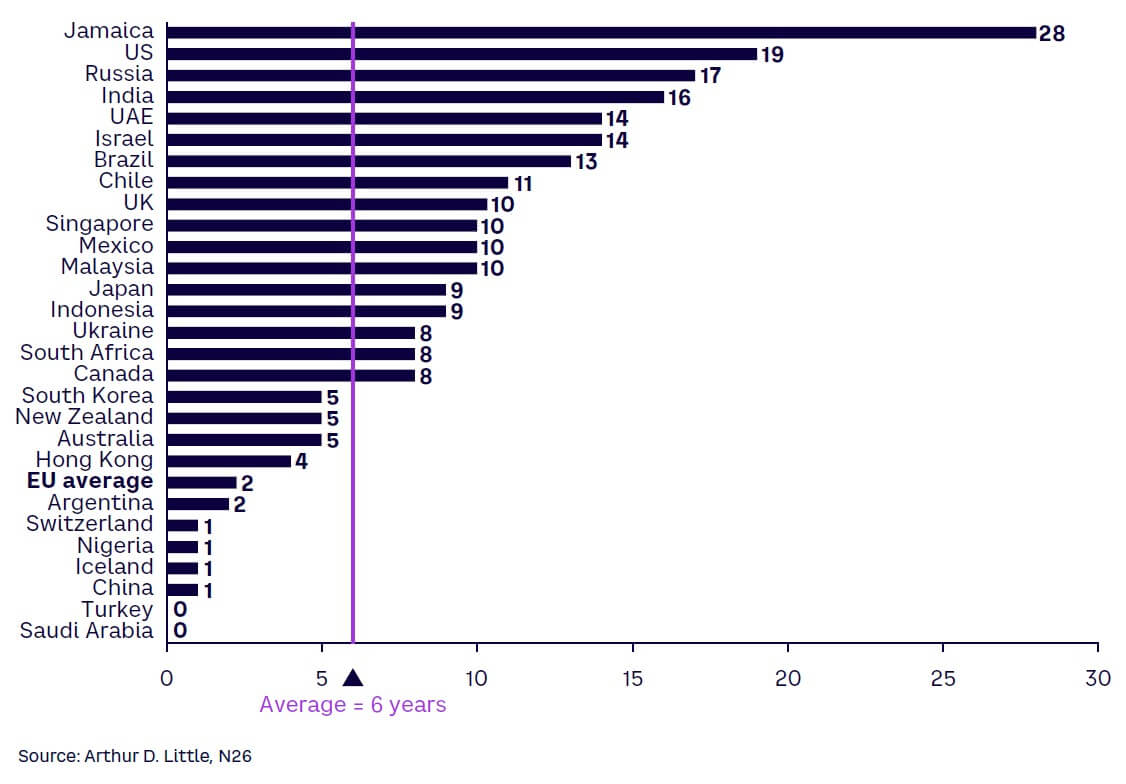
This causes tension as balance is sought between the two potential extremes in mission: a purely research-focused institution versus one dedicated purely to teaching. Universities need to be clear on their role against a backdrop of a globally increasing population, longer lifespans in the developed world, and a need to meet grand challenges around climate change, poverty, inequality, and inequity. Where do they sit on the line between teaching and research, and how will they be able to differentiate themselves in a global market? Only then will they be able to guarantee their long-term sustainability and survival.
THE UNIVERSITY’S ROLE IN NATIONAL DEVELOPMENT PLANS
Universities have long been an extension of a nation’s soft power, building a pipeline of future leaders and driving international perceptions of the national intellectual ecosystem’s quality. This has enabled successful and prestigious institutions to attract talent from across the world, leading to a brain drain from developing countries.
Previously, national plans in developing countries have focused on strengthening access to primary and secondary education, ensuring that all citizens are literate and have the skills needed to contribute to society. As this goal nears achievement, a growing number are now turning their attention to building comprehensive higher education systems to prevent a brain drain and increase national competitiveness (see sidebar “Entrepreneurship studies in national contexts” for one aspect of this transition).
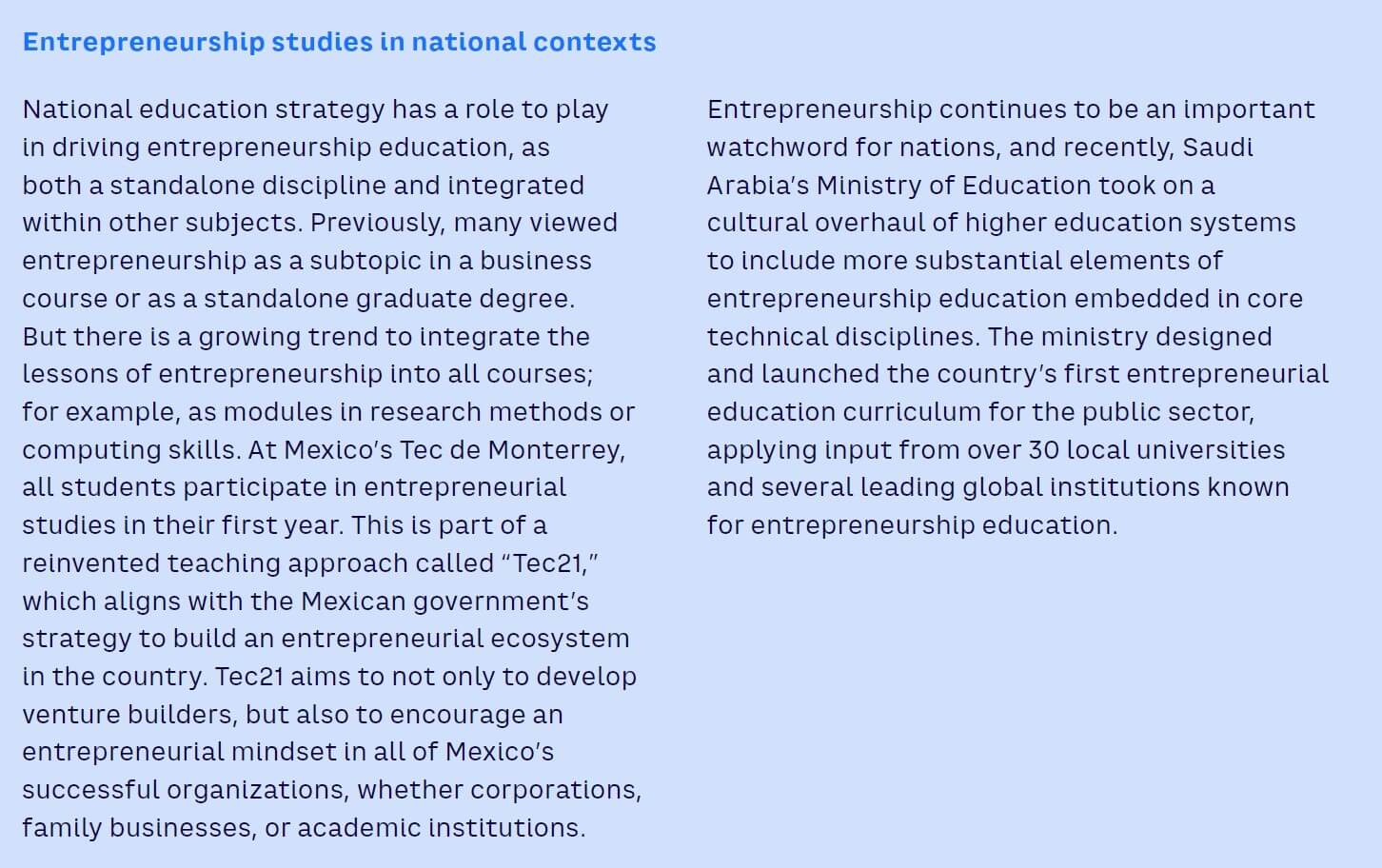
The focus on higher education is driving a specific emphasis on building a system of research-oriented universities that can compete at an elite level. According to some analysis, this has worked in nations like Singapore, where the National University of Singapore is leading technology developments in many fields and training future leaders. Programs in the Middle East are replicating this model, with countries like Saudi Arabia and the United Arab Emirates spending significant portions of their budgets to build national ecosystems for higher education.
However, the degree to which a national ecosystem can be planned and strategically deployed from the central government is not always high, due to institutional independence or the presence of private university institutions. National governments may need to use indirect means, such as funding and quality assurance measures, to tweak the national education landscape. Note that not all national objectives are achievable through focusing on elite research universities; the vast majority of students will not go on to research or undertake a PhD, so quality and excellence in teaching must be guaranteed at all institutions at the undergraduate level.
BALANCING FUNDING SOURCES & THE NEED FOR QUALITY TEACHING
When considering their overall mission and vision, higher education institutions must consider the impact of their sources of funding and how best to guarantee their long-term financial sustainability. This will influence the approach that individual universities take to balancing their research and teaching commitments.
Universities (or more realistically, specific departments) that specialize in, and are good at, research are able to secure more research-related funding from public and private coffers through competitive grants. As a result, they will be able to build state-of-the-art facilities, drawing in more elite researchers and building an ever-stronger reputation for academic excellence. Essentially, success begets success.
Universities with strong teaching offerings are better able to justify high tuition in a global marketplace. Through nurturing high-quality graduates, they will build substantial endowments when those graduates are successful. Moreover, strong teaching institutions are well placed to attract lifelong and professional students who are willing to pay substantial fees for short courses that fit around their work commitments (see sidebar “University rankings”).
However, when deciding on their balance between the two missions, universities need to be careful that these drivers remain virtuous and not to the total detriment of other considerations. Essentially, all universities must target excellence in both teaching and research but recognize their own specific role, function, and strengths.
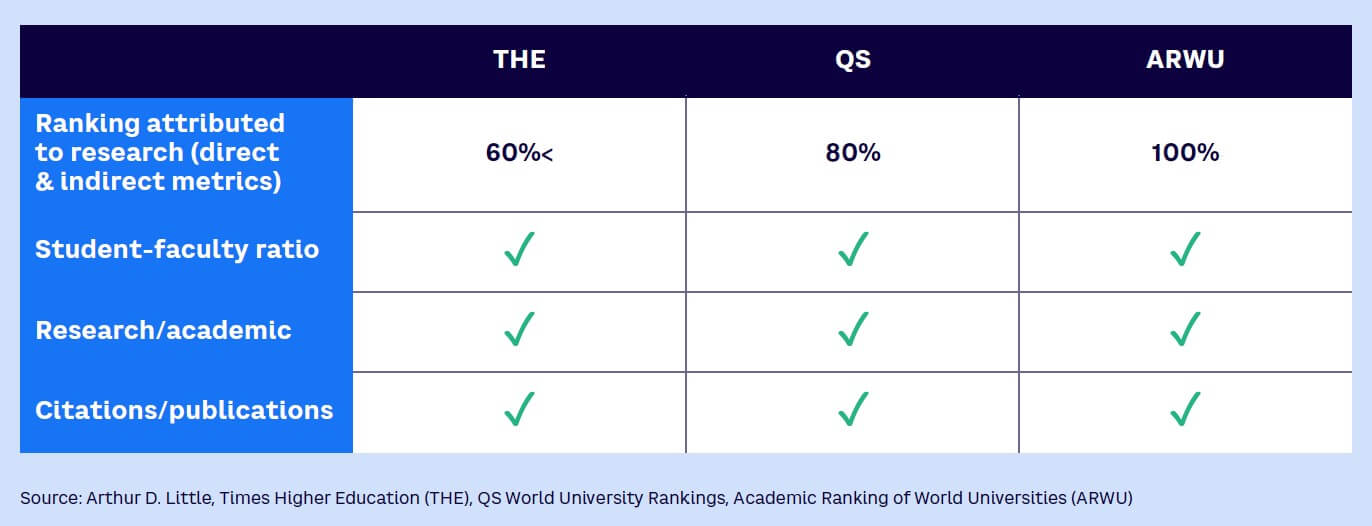
EXPLORING NEW BUSINESS MODELS
With the rise of borderless, lifelong learning, universities need to explore options for new revenue streams. This may be in the form of subscriptions to learning groups (focused on core subjects) but should include proper distance-learning education components beyond a simple, commoditized MOOC. Subscriptions could be offered to businesses and individual learners alike, allowing learners to dip in and out of education throughout the many years they will spend in the workforce.
Alternatively, universities could collaborate in small networks to offer nontraditional routes to formal qualifications: foundation degrees, diplomas, or even full bachelor’s and master’s degrees delivered by the accumulation of distance-learned credits. In a borderless-learning context, there is no significant benefit to the learner or the university in enforcing a time limit of around four years to acquire a qualification.
ADAPTING COURSES TO THE MODERN WORKPLACE
Academic programs must provide opportunities for students to develop transferable skills that will prepare them for life beyond their undergraduate degree. To continue justifying high student costs in the face of alternative learning options with low or no up-front cost, university education must ensure graduates exit institutions ready to be skillful employees. In a growing number of institutions, this means building business skills or entrepreneurship studies into undergraduate degrees outside of the boundaries of the business school.
At a minimum, universities need to focus on ways to increase the level of experiential and personalized learning modes used to deliver core content, aiming to create lifelong learners. The skills developed and the complementary mindset will benefit the students throughout their life, and as a side benefit, will improve the local ecosystem and the university itself by producing better researchers and a more engaged alumni body.
Conclusion
NAVIGATING AN UNCERTAIN FUTURE
Universities are at a crossroads. The traditional balanced higher education model of face-to-face teaching and research across a range of subjects is under threat from digitization, grant-funding concentration, global competition from a wider range of learning options, and changing student demands.
Ironically, universities have never been more necessary — both to foster the innovation required to solve complex and pressing global challenges like climate and sustainability and to provide students of all ages with the lifelong learning skills they need to succeed in a world increasingly disrupted by AI.
As they look forward, universities will need to focus on their sense of purpose and add to their original missions of teaching and research to develop new funding streams that safeguard their futures. Not every institution will survive, and many will be radically reshaped, but those that can differentiate will thrive in a growing, global market where universities add value to all of humanity.
Notes
[1] “Fast Facts: Distance Learning.” Institute of Education Sciences (IES), National Center for Education Statistics (NCES), accessed October 2023.
[2] Conboye, Janina, and Lucy Warwick-Chin. “‘I Feel Left Behind’: Graduates Struggle to Secure Good Jobs.” Financial Times, 27 June 2021.
[3] Slavich, George M., and Philip G. Zimbardo. “Transformational Teaching: Theoretical Underpinnings, Basic Principles, and Core Methods.” Educational Psychology Review, Vol. 24, No. 4, December 2012.
[4] “2023 NACE Internship & Co-op Report & Dashboard.” National Association of Colleges and Employers (NACE), accessed October 2023.
[5] Ibid.
[6] Heaven, Will Douglas. “ChatGPT Is Going to Change Education, Not Destroy It.” MIT Technology Review, Vol. 126, No. 3, May/June 2023.
[7] “The Education Price Index 2022: A Study by N26.” N26, accessed October 2023.
DOWNLOAD THE FULL REPORT
26 min read • Technology & innovation management
The future of higher education, Part I
Balancing new requirements for research, teaching & student needs

DATE

Executive Summary
Since the turn of the millennium, modern universities have adapted and evolved from their public image as traditional old institutions of knowledge. However, they currently face a widening range of challenges brought on by our transforming, globalized world.
Universities must balance the conflicting demands between their traditional mission of teaching and research, while distinguishing themselves within a deepening pool of quality competition in an increasingly borderless market.
On the research side, funding is becoming more concentrated among a smaller group of institutions, but funding models are complex and can change rapidly. Universities are stepping up to share research and play their part in solving current global mega-challenges, driven by increasingly entrepreneurial academics and a focus on new ways of building innovation ecosystems to drive greater commercial relevance and revenues. On the teaching side, the pandemic’s impact on teaching hastened the rise and reach of digital learning — but it also underscored the value of experiential and personalized approaches to study.
Breakthroughs in artificial intelligence (AI), and the rise of commoditized online courses from nontraditional providers, increase pressure on universities. They must deliver quality differentiated teaching to a wider range of students who are looking to invest in lifelong learning and build skills over a longer (or shorter) period than the traditional four-year degree. Student needs are changing, and they increasingly demand a return on the time and money they invest in tuition.
The above conditions mean that individual institutions need to make strategic decisions around their future. Universities need to embrace changes in both how they are structured and how they operate and teach. They must reexamine their strengths in a global context and rethink traditional models around their missions of research and teaching to find their place in a changing world.
In this Report, we analyze the current context, describe the trends driving the higher education environment, and outline potential options for the future, based on a combination of Arthur D. Little (ADL) case work, sector knowledge, and interviews with thought leaders in education.

1
DEFINING THE FUTURE OF LEARNING ENVIRONMENTS
While the pandemic forced an overnight change in the delivery of university teaching, in many ways it simply turbocharged an existing shift toward digital learning, which caused many students and institutions to question how and where learning should take place. This rebalancing is still playing out, driving innovation in course delivery against a backdrop of a greater focus on improving the quality of in-person learning, lifelong learning, and nontraditional teaching options. What will the teaching mission of universities look like in the future?
QUALITY CONTACT TIME VS. COMMODITIZED LEARNING ENVIRONMENT
Since the pandemic required universities to go digital for lectures, seminars, and other learning experiences, there has been a reluctance to fully return to in-person instruction. This comes from both academic and student perspectives to differing degrees and links to changing student needs and a desire to maximize contact time.
While delivering university courses digitally enables institutions to scale up the number of students they can teach (thereby increasing revenue), virtual learning also brings challenges. It increases competition from universities at home and abroad and can lead to a degradation of teaching quality when there’s little to no upgrade in value of in-person time. Teaching institutions must ensure that even brief amounts of contact time with students maximizes the value of their learning. This may lead to “flipped” classrooms: lecture content delivered online but with greater efforts placed on highly interactive tutorials delivered to small groups.
As costs rise and students continue to question the economic value of a university education, there will be a much greater focus on teaching quality and the amount of in-person learning and its ability to affect future job prospects and build transferable skills.
BORDERLESS DELIVERY & DISTANCE LEARNING
The ongoing digital transformation of education provides significant opportunities for universities. It enables students from around the globe to effectively participate in learning activities, while removing constraints on scale in areas such as teaching facilities and student accommodations.
The last few years have shown that most lecture-based teaching can be delivered online. From that perspective, there’s little difference between a student’s bedroom in Cambridge or Santiago. The pandemic’s impact cannot be overstated. In the US, the number of undergraduate students exclusively enrolled in distance education courses was 186% higher in 2020 than 2019 due to the impact of COVID-19.[1] Importantly, those numbers have not changed much in the semesters since.
On the positive side, online learning has the potential to democratize access to some elite universities that have previously been unattainable due to high fees, travel costs, visa or residency restrictions, or living expenses in university towns such as Oxford. If universities wish to democratize learning, then borderless, digital delivery seems like an obvious enabler.
Distance learning is not new; the UK’s Open University began its primarily distance-learning programs in 1969. However, the continued growth of Web collaboration tools — video calls, virtual whiteboards, simultaneous-editing software, and potentially aspects of the Metaverse — further erodes the perceived barriers to educational delivery from afar. How institutions manage this shift and balance the physical and digital sides of their teaching mission will have fundamental impacts on their student numbers, revenues, and their ability to recruit potential researchers and academics in the future.
LIFELONG LEARNING
Today, people studying for a first degree are expected to change careers three to five times during their working life. One impact of this is a renewed drive for lifelong learning and upskilling in the professional workplace: applications to both online and in-person MBAs were up over 20% in 2021.[2] Global workplaces recognize that training and continuing professional development are key to attracting and retaining talent. Employers generally see this as a win-win; their employees gain skills, perform better, and have more reasons to remain with their employer. As technological inventions continue to change the modern workplace (witness the ongoing AI revolution), all employees will need to regularly learn new skills.
To meet their learning and development goals, many businesses have established partnerships with online educational content providers such as LinkedIn Learning, Kubicle, and Udemy. These courses range from basic topics, such as how to get the most out of spreadsheet software to more complex courses that delve into project management, sales, and business leadership. However, while the vast range of available options rewards the curious, these courses provide a relatively passive learning process that culminates in a quick test at the end of a video module. The student may engage with the course, but the actual learning reward is low.
In parallel, universities have gradually expanded the availability of massive open online courses (MOOCs), with educators from elite institutions adding more and more courses to platforms like edX and Coursera. In many cases, these courses are provided gratis or funded by modest accreditation fees from successful students. However, even within the academic field, the focus of course content has traditionally been around specific, job-related skills like business management and digital technology specialties such as data science. Relatively few rigorous options exist for ongoing and lifelong learning in core academic subjects — pure sciences, history, philosophy, literature — whether the goal is to build degree-equivalent knowledge or explore a new interest with the goal of becoming a more well-rounded individual.
Despite the boom in distance-learning, few options are available for professional or lifelong learning that fit around work schedules in the same way as an executive MBA, which combines intense, residential courses interspersed with distance learning over a multiyear period. This blueprint shows a way forward for universities and could even be enhanced through collaboration across institutions, allowing more open access to learning environments and providing micro-credentialed courses that over time may result in a degree. In this paradigm, a completed degree is not always necessary for lifelong learners, whose needs and interests may change depending on their current job, projects, and capability gaps. It is therefore important to allow for short or extended breaks, with flexible commitment and options to transfer credits gained into a foundation degree or other diploma.
All this means that universities need to innovate by offering options for shorter courses to capture interest and tuition dollars from the growing number of lifelong learners. Failure to do so will potentially undermine access to a lucrative, long-term teaching opportunity, which other international institutions or online-first players like LinkedIn Learning could capture. The sidebar “University MOOCs” lists some nonacademic content partners and the courses that generated the most interest.

EXPERIENTIAL LEARNING
Experiential learning, which puts theory into practice, continues to grow. Rather than sitting in a lecture room or checking in online to passively absorb information, students are actively involved in learning and given the chance to explore and reflect on topics in a variety of situations: group discussions and projects, simulations and practicals, field exercises, and independent research, among others. Experiential learning has been shown to improve student satisfaction and understanding of key course materials,[3] as well as increasing the quality of in-person classes and improving students’ perceived value for the money.
The experiential approach is already common in certain settings, such as business schools, where case discussions, simulations, and project work (often examining real problems from real businesses) are the norm.
Experimental practicals have been part of science subjects and medicine since antiquity. Law students hold moot courts and mock trials to learn the art of argument and understand the reality of interpreting statutes. These opportunities help students apply their knowledge far beyond their theoretical understanding of course materials.
There are a multitude of ways to increase the use of experiential learning in the classroom, with different, potentially competing, pedagogies, such as problem-based learning, action learning, and simulation learning. Each approach focuses on a set of tools the educator can use to empower their students and help them learn more effectively.
There is a clear and growing trend to extend experiential learning to other settings. For instance, history students at Queen’s University in Kingston, Ontario, Canada, are offered the opportunity to gain degree credits through internships as archival and research assistants within the university or with a variety of partner museums. Similar programs at other universities may focus on capturing oral histories or curation. Universities, and more importantly, employers, are encouraging students to engage in internship programs, with employers expecting to offer 9.1% more internships in 2023 following an already-substantial increase of 22.6% in 2022 (see Figure 1).[4] These programs act as differentiators for courses, drawing in a wider set of students and also, in theory at least, hitting that key modern KPI for universities: graduate employment rate.

At least to some degree, the growing rise of experiential learning is in opposition to the trend of increased digitalization. In its most common form, structured classroom discussions, experiential learning puts face-to-face student interactions at the forefront of teaching. This type of interaction was most challenged by the pandemic-enforced switch to digital-first teaching and shows the need for balance between the physical and the virtual worlds.
While future Metaverse environments may solve issues of fidelity, providing remote interactions with the same levels of quality and immersivity as in-person groups, this currently seems a long way off.
However, to increase its adoption, experiential learning may need to overcome challenges in how people perceive it. For many, the key benefits of experiential learning are that it builds transferable skills that make students more employable, a concept that is challenging for many academics. These educators need to understand that experiential learning is also a powerful method for reinforcing, exploring, and testing subject-specific knowledge, and it well prepares students to become effective researchers, should they choose that pathway (see sidebar “Case study — Olin College of Engineering”).
Students who take a paid internship are more than twice as likely to land full-time job offers after graduation (see Figure 2). Even those who accept unpaid internships still benefit from the experiential learning, with a 1.2x increase in job offers received.[5]

PERSONALIZED LEARNING
Students want a personalized learning experience. Currently, most students can select modules within degree programs or come to university undeclared and gradually specialize, but these are examples of modularity — not true personalization. Within each block of the learning journey, students are expected to do the same problem sets, attend the same lectures, and examine the same concepts.
By contrast, personalized learning recognizes that students bring their own context, ways of working, and personal goals to the classroom environment. The learning journey therefore needs to be customized, at least somewhat, to meet these needs.
Personalized learning thrives on direct, individual contact between teacher and student. Without this connection, it is difficult to truly adapt teaching materials to the needs of the student.
The Universities of Cambridge and Oxford in the UK offer examples of undergraduate teaching utilizing an approach that relies on small discussion groups commonly comprised of two students and one supervisor. This configuration allows for a high degree of personalization and a focus on topics and challenges individual to each student. Though this approach to teaching is consistently perceived as powerful, it places a large time burden on academics and is expensive to deliver. However, even this framework does not necessarily represent truly personalized teaching; students are expected to follow the same reading list and listen to the same lectures as the rest of their cohort and answer the same questions to explore themes at the same time.
In general, project work can provide more fruitful opportunities for personalization, whether in a group or independently, which ties in with experiential learning. Within a set assessment framework, not all projects will focus on the same topic, or be completed following the same process, as long as students are given opportunities to develop and show key skills that are relevant to the course. Project teams can be structured to allow each student to focus on a particular topic or skill that they wish to develop further.
Delivering personalization at scale is a key challenge recognized by educators. The role of technology in supporting personalization remains unclear, with many believing it simply increases choice, rather than encouraging students’ drive to learn and seek out knowledge on their own. If it can be delivered cost-effectively and at scale, personalized teaching, delivered in person or virtually, provides a key path for universities to meet changing student needs and differentiate themselves from their peers.
CORPORATE-LED RECRUITMENT & TRAINING PROGRAMS
Within certain industries, particularly the technology sector, students are increasingly looking toward nontraditional teaching options. For example, bootcamp-style courses — intensive, immersive, and experiential — promise to teach the fundamentals of a skill in an incredibly compressed time frame. Crucially, many of these systems do not take an up-front fee but instead request payment based on results (e.g., getting a job in a new sector or a significant pay and/or responsibility increase).
This is an ideal approach for many students. Courses are short; minimizing up-front investment in time and opportunity cost, widening the potential applicant pool to candidates with nontraditional backgrounds. The connection to industry is particularly appealing, as for many the aim is to retrain and upskill to earn higher wages and more stable career options.
Corporate training and certification programs are also gaining popularity. For instance, many technology companies provide online platforms that offer employees the chance to become certified in their technology, with learners working toward gaining levels or badges and increasing their employability options.
There is a positive side here: any student with Internet access has multiple options to learn vocational skills that are vital across different industries and working environments. Often, learning opportunities are tightly tied to an industry (or company) and administered through industry-sponsored courses at universities, online bootcamps, and other learning environments.
However, there is a risk that such courses teach students specific ways of working and thinking that most benefit the corporation of employment, not the student.
While many academics wouldn’t consider corporate-led education the democratization of learning, it does provide students with a greater range of options. However, it may result in students forgoing traditional university programs and courses, which would pose a challenge to some institutions.
AI’S IMPACT ON STUDENT EXPERIENCE & LEARNING
Educators clearly cannot ignore the AI-sized elephant in the room. Students have more capability at their fingertips than ever before, not just around access to information, but through access to generative AI technologies such as ChatGPT and the underlying technology of large language models (LLMs). This will continue to develop at a pace that will inevitably feel unpredictable and difficult for institutions to manage. As in many sectors, adapting to new AI tools in education will take time, and appropriate ethics guidance is needed to deal with challenges such as underlying data and idea ownership for LLMs, which make discussions on plagiarism and accusations of cheating even more charged.
This changing, AI-driven world requires institutions to build critical thinking skills in all students: traditional undergraduates and graduates, working students, and lifelong learners and teach them ethical ways of working that set sensible boundaries for utilizing AI in the classroom. As Will Douglas Heaven wrote in the MIT Technology Review earlier this year, cheating is not a new phenomenon in higher education, and “schools have survived calculators, Google, Wikipedia, essays-for-pay websites, and more.”[6] Outright bans on using such technology are counterproductive, as generative AI technologies will become folded into the workplace across creative and knowledge industries, and are likely to be quickly circumvented by technology developers and students. Working with AI tools will be an expected skillset of graduates, much like data analysis in spreadsheet software or research skills beyond googling.
The new reality of LLMs actually increases the need for universities to provide personalized and experiential learning, with the student at the center of the learning environment, developing skills and knowledge in ways that (currently, at least) can’t be outsourced to AI. An experiential learning environment leaves little room to hide for a student who is overly reliant on hands-off tools to research and make decisions. Some educators are even using ChatGPT in an experiential learning setting: using the AI-driven tools as a collaborator in roleplay scenarios and debates or using (flawed) outputs from the LLM to trigger class discussions on reliability and accuracy of sources.
As the power of LLM technologies improves, the applications may become more and more focused on personalization of materials and assignments. Academics who test the waters with these general techniques will now be able to better leverage the next generation of education-specific tools and ultimately drive better student-centric outcomes.
2
WHAT SETS ELITE UNIVERSITIES APART?
Popular culture often espouses the view of universities as ivory towers, with academics walking the dusty halls of venerable institutions, conducting brilliant research and making breakthroughs in relative isolation.
The reality is undoubtedly different: the modern academic is engaged and entrepreneurial, well-networked, and works with partners, all the while conducting research. While this has always been true to a degree, research is constantly adapting to the changing pressures of the modern world, and the ecosystems built around university research and researchers are becoming ever more complex as a consequence.
The source of tension in university research comes from the drive toward applying research (research impact, in the language of funding bodies) and genuine blue-sky thinking. With funding and institutional war chests even more stretched, openings for truly revolutionary investigations seem tighter than at any point since World War II. How institutions maintain their identity and raison d’etre or redefine themselves without simply becoming cost-effective innovation centers for industry, will determine the winners and losers for the next phase of university development.
Research plays a fundamental role in university life, and it is growing in importance as a revenue source and a means of bringing prestige to the institution. Educators and universities are becoming more entrepreneurial as they build wider innovation ecosystems around their research strengths.
RESEARCH FUNDING FOCUSES ON ELITE INSTITUTIONS
Across the globe, R&D excellence is a key criterion for accessing any form of research funding, especially public grants. In 2022, for example, 80% of the UK’s research councils’ funding went to just 10% of higher education institutions (of about 200 total institutions) as shown in Figure 3. To succeed and attract grant funding, universities must be able to prove the efficacy, relevancy, and impact of their research programs.

Universities often have to comply with a complex mix of KPIs when verifying their research success. These include research-related indicators such as successful patent applications and direct research-evaluation mechanisms.
High-quality research benefits a university in ways beyond the grant. It helps attract talented academic staff and facilitates international collaborations. In turn, these outcomes allow the university to compete for global students by trading on the prestige associated with its reputation (see Figure 4).

A CHALLENGING PICTURE FOR OVERALL FUNDING
Public funding for higher education continues to be challenging in many countries. In Europe, reforms to public funding were put on hold during the academic years 2019–2020 and 2020–2021 due to the impacts of the pandemic, and tuition costs are expected to remain largely static, despite inflationary factors. These conditions increase the pressure on universities to maximize their research income. On the positive side, many governments (e.g., Saudi Arabia, Singapore, and Malaysia) have increased funding in both relative and absolute terms, wanting to realize the potential their universities have to gain national prestige.
Funding challenges mean that research remains a critical driver for university revenue in terms of direct public funding, whether in the form of research grants or through funding formulas. However, basing a university business plan solely on public funding for research and teaching seems destined to lead to complications in the short and medium term, as KPIs can shift rapidly. If states move away from direct funding models or focus their funding on a handful of prestigious, highly effective, and focused research institutions, questions will arise on the funding model for the majority of non-research-intensive institutions in the landscape.
ENTREPRENEURIAL PROFESSORS DRIVE THEIR OWN DESTINY
Leading academics have long been multitaskers: overseeing research initiatives, raising funds, mentoring postgraduate students, and lecturing undergraduates. Senior academics shoulder the additional weight of facilitating public outreach and wooing alumni and businesses for donations; their role is clearly complex and multifaceted.
Despite their already significant workloads, there is an increasing trend for professors to secure their own incomes outside the university system: whether through collaborations with publishers to write textbooks (often taking a sabbatical) or via freelance engagements, such as working with governments, nongovernmental organizations, nonprofits, businesses, media groups, and consultancies as advisors with expertise in particular topics.
A professor’s professional network is key to entrepreneurship, as shown in Figure 5. Their ability to leverage global contacts (built through conference attendance, research collaborations, and industry partnerships) to form a sustainable pipeline of extracurricular activities is vital.

The student body also should be seen as part of the professor’s network; early career entrepreneurs frequently look to their professors for mentorship and advice, which may be converted into lucrative positions on boards or advisory committees.
While some advisory positions might be organized through the university, most external roles are accessed independently. In this regard, professors are not always well served by their understanding of contracts, business operations, or the value they add and would benefit from professional training from their institution or, if applicable, their union. Courses in entrepreneurship can provide the knowledge they need to consider entrepreneurship (see sidebar “Case study — Teaching researchers to be entrepreneurial”).

INFRASTRUCTURE INVESTMENTS SUPPORT UNIVERSITY INNOVATION
Because of the challenges around research funding, universities increasingly look to leverage existing assets and capabilities to create revenue streams that go beyond a pure intellectual property (IP) offer. The trend for creation of innovation districts, technology valleys, or advanced research parks is growing. This encourages spinouts, noninstitutional start-ups, and large flagship businesses with locations in the heart of the university campus, with ready access to students, recent graduates, and facilities.
Innovation districts (see sidebar “Innovation districts go beyond traditional TTO”) are not simply operating a technology transfer office (TTO), which focuses on maintaining and directly utilizing the institution’s IP. Instead, these entities aim to create a cooperative ecosystem of public and private research, in which (from the university’s perspective) spinouts are created regularly and have a higher chance of succeeding. This will ideally benefit the university’s revenue stream in the long term.

However, an innovative ecosystem also delivers wider benefits. It provides a diverse pool of engaged resources for the university to collaborate with, creating an open-door policy between the public and private sector. Ultimately, this should result in a more vibrant, more collaborative, and more varied university campuses, with research activities happening daily to benefit both the long-term prospects of students and the university’s daily teaching and learning.
Universities at the beginning of their innovation district journey should ensure these programs do not focus solely on STEM (science, technology, engineering, math) subjects and that students and faculty members from arts, humanities, social sciences, and business are welcomed and integrated into the ecosystem, not just as employees of innovative businesses (e.g., marketers, finance experts, lawyers), but fundamentally as cocreators and collaborators. Diverse skill sets and personal experiences will drive higher chances of success, and an innovation district should ultimately aim to become a collision space for interdisciplinary working.
It is critical for a university to consider how to create a careful balance between commercially focused research that could deliver venture capital or licensing returns and the type of fundamental research projects that are central to a university mission.
3
ADAPTING TO A CHANGING WORLD
The needs of students, governments, and the wider community are changing. This calls into question the overall mission of universities at an individual, institutional level. What value do they bring, and how do they justify their funding in a transforming world? How should they structure themselves to differentiate and add value? The answer requires them to understand and act on a number of challenges.
RELIEVING THE TENSION BETWEEN RESEARCH & TEACHING
Universities are under pressure from a globally mobile, demanding, and financially literate student base and a narrowing of research funding to a small group of institutions.
They therefore face a growing challenge to define their purpose and mission: is their university of the future a place for learning or a place for research? Traditionally, many have done both. After all, the two are intertwined; students benefit significantly from academics who are world-renowned experts in their field, and excellence in teaching creates a cohort of engaged researchers.
However, the skills required to be an academic expert and those of an engaging teacher are very different. The stereotype of the professor who is reluctant to leave the lab to teach or simply reads from their latest work still holds a grain of truth. In many parts of the world, students pay significant sums of money to universities, incurring lifelong debt in the process, so they increasingly seem within their rights to expect and demand high-quality teaching (see Figure 6).[7]

This causes tension as balance is sought between the two potential extremes in mission: a purely research-focused institution versus one dedicated purely to teaching. Universities need to be clear on their role against a backdrop of a globally increasing population, longer lifespans in the developed world, and a need to meet grand challenges around climate change, poverty, inequality, and inequity. Where do they sit on the line between teaching and research, and how will they be able to differentiate themselves in a global market? Only then will they be able to guarantee their long-term sustainability and survival.
THE UNIVERSITY’S ROLE IN NATIONAL DEVELOPMENT PLANS
Universities have long been an extension of a nation’s soft power, building a pipeline of future leaders and driving international perceptions of the national intellectual ecosystem’s quality. This has enabled successful and prestigious institutions to attract talent from across the world, leading to a brain drain from developing countries.
Previously, national plans in developing countries have focused on strengthening access to primary and secondary education, ensuring that all citizens are literate and have the skills needed to contribute to society. As this goal nears achievement, a growing number are now turning their attention to building comprehensive higher education systems to prevent a brain drain and increase national competitiveness (see sidebar “Entrepreneurship studies in national contexts” for one aspect of this transition).

The focus on higher education is driving a specific emphasis on building a system of research-oriented universities that can compete at an elite level. According to some analysis, this has worked in nations like Singapore, where the National University of Singapore is leading technology developments in many fields and training future leaders. Programs in the Middle East are replicating this model, with countries like Saudi Arabia and the United Arab Emirates spending significant portions of their budgets to build national ecosystems for higher education.
However, the degree to which a national ecosystem can be planned and strategically deployed from the central government is not always high, due to institutional independence or the presence of private university institutions. National governments may need to use indirect means, such as funding and quality assurance measures, to tweak the national education landscape. Note that not all national objectives are achievable through focusing on elite research universities; the vast majority of students will not go on to research or undertake a PhD, so quality and excellence in teaching must be guaranteed at all institutions at the undergraduate level.
BALANCING FUNDING SOURCES & THE NEED FOR QUALITY TEACHING
When considering their overall mission and vision, higher education institutions must consider the impact of their sources of funding and how best to guarantee their long-term financial sustainability. This will influence the approach that individual universities take to balancing their research and teaching commitments.
Universities (or more realistically, specific departments) that specialize in, and are good at, research are able to secure more research-related funding from public and private coffers through competitive grants. As a result, they will be able to build state-of-the-art facilities, drawing in more elite researchers and building an ever-stronger reputation for academic excellence. Essentially, success begets success.
Universities with strong teaching offerings are better able to justify high tuition in a global marketplace. Through nurturing high-quality graduates, they will build substantial endowments when those graduates are successful. Moreover, strong teaching institutions are well placed to attract lifelong and professional students who are willing to pay substantial fees for short courses that fit around their work commitments (see sidebar “University rankings”).
However, when deciding on their balance between the two missions, universities need to be careful that these drivers remain virtuous and not to the total detriment of other considerations. Essentially, all universities must target excellence in both teaching and research but recognize their own specific role, function, and strengths.

EXPLORING NEW BUSINESS MODELS
With the rise of borderless, lifelong learning, universities need to explore options for new revenue streams. This may be in the form of subscriptions to learning groups (focused on core subjects) but should include proper distance-learning education components beyond a simple, commoditized MOOC. Subscriptions could be offered to businesses and individual learners alike, allowing learners to dip in and out of education throughout the many years they will spend in the workforce.
Alternatively, universities could collaborate in small networks to offer nontraditional routes to formal qualifications: foundation degrees, diplomas, or even full bachelor’s and master’s degrees delivered by the accumulation of distance-learned credits. In a borderless-learning context, there is no significant benefit to the learner or the university in enforcing a time limit of around four years to acquire a qualification.
ADAPTING COURSES TO THE MODERN WORKPLACE
Academic programs must provide opportunities for students to develop transferable skills that will prepare them for life beyond their undergraduate degree. To continue justifying high student costs in the face of alternative learning options with low or no up-front cost, university education must ensure graduates exit institutions ready to be skillful employees. In a growing number of institutions, this means building business skills or entrepreneurship studies into undergraduate degrees outside of the boundaries of the business school.
At a minimum, universities need to focus on ways to increase the level of experiential and personalized learning modes used to deliver core content, aiming to create lifelong learners. The skills developed and the complementary mindset will benefit the students throughout their life, and as a side benefit, will improve the local ecosystem and the university itself by producing better researchers and a more engaged alumni body.
Conclusion
NAVIGATING AN UNCERTAIN FUTURE
Universities are at a crossroads. The traditional balanced higher education model of face-to-face teaching and research across a range of subjects is under threat from digitization, grant-funding concentration, global competition from a wider range of learning options, and changing student demands.
Ironically, universities have never been more necessary — both to foster the innovation required to solve complex and pressing global challenges like climate and sustainability and to provide students of all ages with the lifelong learning skills they need to succeed in a world increasingly disrupted by AI.
As they look forward, universities will need to focus on their sense of purpose and add to their original missions of teaching and research to develop new funding streams that safeguard their futures. Not every institution will survive, and many will be radically reshaped, but those that can differentiate will thrive in a growing, global market where universities add value to all of humanity.
Notes
[1] “Fast Facts: Distance Learning.” Institute of Education Sciences (IES), National Center for Education Statistics (NCES), accessed October 2023.
[2] Conboye, Janina, and Lucy Warwick-Chin. “‘I Feel Left Behind’: Graduates Struggle to Secure Good Jobs.” Financial Times, 27 June 2021.
[3] Slavich, George M., and Philip G. Zimbardo. “Transformational Teaching: Theoretical Underpinnings, Basic Principles, and Core Methods.” Educational Psychology Review, Vol. 24, No. 4, December 2012.
[4] “2023 NACE Internship & Co-op Report & Dashboard.” National Association of Colleges and Employers (NACE), accessed October 2023.
[5] Ibid.
[6] Heaven, Will Douglas. “ChatGPT Is Going to Change Education, Not Destroy It.” MIT Technology Review, Vol. 126, No. 3, May/June 2023.
[7] “The Education Price Index 2022: A Study by N26.” N26, accessed October 2023.
DOWNLOAD THE FULL REPORT

